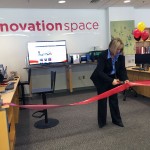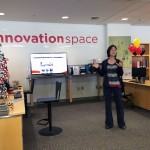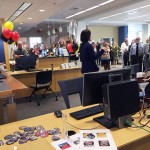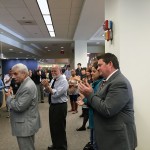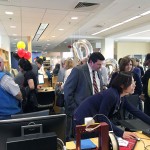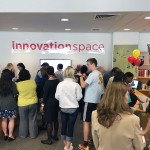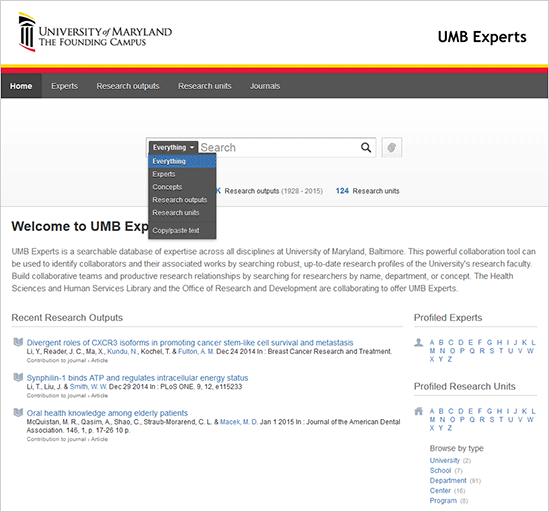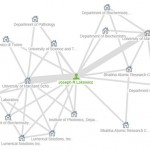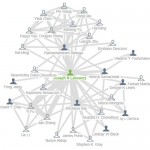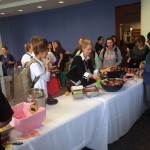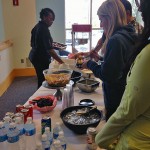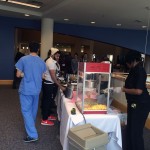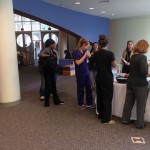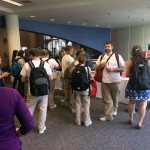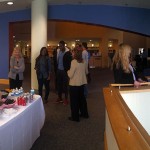
BioLogik Labs – A new Norfolk biohackerspace
A biohackerspace is a community laboratory that is open to the public. A biohackerspace is a biotechnological version of hackerspace where the public is encouraged to come learn about biotechnology and experiment with DNA, bacteria, and cells. Like makerspaces, biohackerspaces provide people with tools not usually available at home. Biohackerspaces, however, contain tools such as microscopes, Petri dishes, freezers, and PCR (Polymerase Chain Reaction) machines rather than 3D printers, CNC milling machines, and laser cutters. Biohackers tinker with bacteria, cells, and DNA rather than computer code, electronics, plastic, and other materials for DYI-manufacturing. Genspace in Brooklyn, founded by molecular biologist Ellen Jorgenson in 2010, was the first biohackerspace in the United States. Since then, more biohackerspaces have opened, such as BUGSS (Baltimore Underground Science Space) in Baltimore, BioLogik Labs in Norfolk, BioCurious in Sunnyvale, Berkeley BioLabs in Berkeley, Biotech and Beyond in San Diego, and BioHive in Seattle.
According to Meredith Patterson, a notable biohacker who advocates citizen science, scientific literacy is not understanding science but doing science. In her 2010 talk at the UCLA Center for Society and Genetics’ symposium, “Outlaw Biology? Public Participation in the Age of Big Bio,” Patterson argued, “scientific literacy empowers everyone who possesses it to be active contributors to their own health care; the quality of their food, water, and air; their very interactions with their own bodies and the complex world around them.”
Biohackerspaces democratize access to biotechnology equipment and space, and enable users to share their findings. In this regard, biohakerspaces are comparable to the open-source movement in computer programming. Both allow people to solve the problems that matter to them. Rather than pursing scientific breakthroughs, Biohackers and the advocates of the DIYbio movement are looking for solutions to small but important problems. Large institutions, such as big pharmaceutical companies, may not pursue solutions to such problems unless they are sufficiently profitable. For example, China experienced a major food safety incident in 2008 involving melamine-contaminated milk and infant formula. Testing milk for the presence of melamine in a lab costs thousands of dollars. After reading about the incident, Patterson created an alternative test, which costs only a dollar and can be done in a home kitchen. To solve the problem, she spliced a glow-in-the-dark jellyfish gene into the bacteria that turns milk into yogurt and then added a biochemical sensor that detects melamine. If the milk turns green when combined with this mixture, it contains melamine.
Biohackers pursue a variety of projects ranging from making bacteria that glows in the dark by injecting a luminescent gene to identifying neighbors who fail to clean up after their dogs by comparing DNA from dog excrement with that of saliva samples taken from the neighbors’ dogs. You can also test if the food item that you bought at a supermarket is what it is advertised to be; work on creating bacteria that will decompose plastic; check if a certain risky gene is present in your body. If you are an investigational journalist, you may use your biohacking skills to verify certain evidence. If you’re a citizen concerned about the environment, you can check the pollution level of your city or neighborhood and find out if particular pollutants exceed legal limits.
DIYbio enthusiasts pursue most of these projects as a hobby. But some projects hold the potential to solve serious global problems. For example, Biopunk, a book by Marcus Wohlsen (p. 56) describes a DIYbio approach to develop an affordable handheld thermal cycler that rapidly replicates DNA as an inexpensive diagnostics for the developing world. Used in conjunction with a DNA-reading chip and a few vials containing primers for a variety of disease, this device called ‘LavaAmp’ can quickly identify diseases that break out in remote rural areas.
The DIYbio movement recognized the potential risk in biohacking early on and created codes of conduct in 2011. The Ask a Biosafety Expert (ABE) service at DIY.org provides free biosafety advice from a panel of volunteer experts, along with many biosafety resources. Some biohackerspaces have an advisory board of professional scientists who review the projects that will take place at their spaces. Most biohackerspaces meet the Biosafety Level 1 criteria set out by the CDC.
While the DIYbio movement and biohackerspaces are still in the early stage of development, they hold great potential to drive future innovation in biotechnology and life sciences. The DIYbio movement and biohackerspaces try to transform ordinary people into citizen scientists, empower them to come up with solutions to everyday problems, and encourage them to share those solutions with one another. Not long ago, we had mainframe computers that were only accessible to a small number of professional computer scientists locked up at academic or corporate labs. Now personal computers are ubiquitous, and many professional and amateur programmers know how to write code to make a personal computer do the things they would like it to do. Until recently, manufacturing was only possible on a large scale through factories. Many makerspaces that started in recent years, however, have made it possible for the public to create a model on a computer and 3D print a physical object based on that model at a much lower cost and on a much smaller scale. It remains to be seen if the DIYbio movement and biohackerspaces will bring similar change to biotechnology.
Bohyun Kim, Associate Director, Library Applications and Knowledge Systems
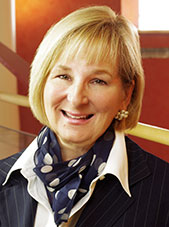

 The Library Genie is coming back! Last year he asked for your 3 library wishes and you responded. We can happily say that 3 library wishes were granted.
The Library Genie is coming back! Last year he asked for your 3 library wishes and you responded. We can happily say that 3 library wishes were granted.

 Here are some helpful hints on how the HS/HSL can help you as the school year begins.
Here are some helpful hints on how the HS/HSL can help you as the school year begins.
 MPowering the State was established a few years ago by the University System of Maryland Board of Regents to promote innovation and impact through collaboration between the University of Maryland, Baltimore and the University of Maryland, College Park. MPowering the State provided one-time funds, to be reviewed and renewed annually, for shared library collections supporting this collaboration. The University Libraries at College Park, and the Health Sciences and Human Services Library and the Thurgood Marshall Law Library at UM Baltimore employed these funds to establish the MPower Virtual Research Library, an interdisciplinary collection supporting advanced biosciences research and education between these universities.
MPowering the State was established a few years ago by the University System of Maryland Board of Regents to promote innovation and impact through collaboration between the University of Maryland, Baltimore and the University of Maryland, College Park. MPowering the State provided one-time funds, to be reviewed and renewed annually, for shared library collections supporting this collaboration. The University Libraries at College Park, and the Health Sciences and Human Services Library and the Thurgood Marshall Law Library at UM Baltimore employed these funds to establish the MPower Virtual Research Library, an interdisciplinary collection supporting advanced biosciences research and education between these universities.




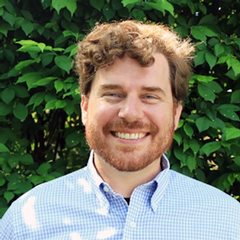




 After listening to your suggestions at our Student Town Hall and through our Library Genie survey, we understand that you want more library hours. We are happy to announce that we can now offer early morning study from 6:00 a.m. to 8:00 a.m., Monday through Friday. For access to the HS/HSL before 8:00 a.m., simply enter through the SMC Campus Center with your UMB ID badge. Library services and access to classrooms begin at 8:00 a.m., when the HS/HSL’s front doors open. Occasionally, computers and printers will not be available during early morning study hours due to routine network updates.
After listening to your suggestions at our Student Town Hall and through our Library Genie survey, we understand that you want more library hours. We are happy to announce that we can now offer early morning study from 6:00 a.m. to 8:00 a.m., Monday through Friday. For access to the HS/HSL before 8:00 a.m., simply enter through the SMC Campus Center with your UMB ID badge. Library services and access to classrooms begin at 8:00 a.m., when the HS/HSL’s front doors open. Occasionally, computers and printers will not be available during early morning study hours due to routine network updates.
 Five preeminent medical libraries, including the HS/HSL, are collaborating on a project to digitize state medical journals. The Medical Heritage Library (MHL), is a digital resource on the history of medicine and health developed by an international consortium of cultural heritage repositories. The MHL has received funding in the amount of $275,000 from the National Endowment for the Humanities for its proposal, “Medicine at Ground Level: State Medical Societies, State Medical Journals, and the Development of American Medicine and Society.” Additional funding has been provided by the Harvard Library.
Five preeminent medical libraries, including the HS/HSL, are collaborating on a project to digitize state medical journals. The Medical Heritage Library (MHL), is a digital resource on the history of medicine and health developed by an international consortium of cultural heritage repositories. The MHL has received funding in the amount of $275,000 from the National Endowment for the Humanities for its proposal, “Medicine at Ground Level: State Medical Societies, State Medical Journals, and the Development of American Medicine and Society.” Additional funding has been provided by the Harvard Library.
 The HS/HSL opened its Innovation Space on Tuesday, April 21. We welcome all UMB students, faculty, and researchers who are interested in experimenting with 3D printing and 3D scanning. The HS/HSL will be developing the Innovation Space as a vibrant and collaborative hands-on learning space on campus and will be offering workshops and hosting talks in the future. The Innovation Space is equipped with two 3D printers (MakerBot Replicator 2X and Afinia H480), a 3D Systems Sense 3D scanner, Lynda.com video tutorials, a large DNA model, two molecule kits, and a button maker. The cost for 3D printing is $3.00 for up to an hour of 3D printing and $1.00 for each additional hour.
The HS/HSL opened its Innovation Space on Tuesday, April 21. We welcome all UMB students, faculty, and researchers who are interested in experimenting with 3D printing and 3D scanning. The HS/HSL will be developing the Innovation Space as a vibrant and collaborative hands-on learning space on campus and will be offering workshops and hosting talks in the future. The Innovation Space is equipped with two 3D printers (MakerBot Replicator 2X and Afinia H480), a 3D Systems Sense 3D scanner, Lynda.com video tutorials, a large DNA model, two molecule kits, and a button maker. The cost for 3D printing is $3.00 for up to an hour of 3D printing and $1.00 for each additional hour.
